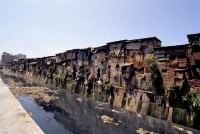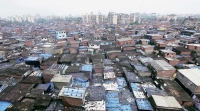Dharavi - Miserable Life In The Slums

“LIFE AT DHARAVI”
Dharavi, Mumbai is Asia's second largest slum spread over an area of roughly 557 acres. This article is not aimed at informing the world about what the generalized viewpoint regarding Dharavi and especially a slum area. Undoubtedly there are a million reasons one can have to pity Dharavi but the real picture is something really different.
Dharavi is home for close to a million people and it shelters a variety of people with a wide range of occupations. Most of the people in Dharavi are daily workers and have to spend a tuff life working almost 12 hours a day.The major occupation of people here is the waste collection and segregation waste being the only thing that costs nothing to have and can give a considerable benefit on being sold.
Having known that an aspect of Dharavi is also that it is market to some of the finest leather goods that are manufactured and sold in Dharavi itself. It is difficult to believe but there are people in Dharavi who travel daily to foreign marketplaces to get their goods sold and they are not poor rather have a good source of income. Visitors from around the globe come to Dharavi to buy leather goods.Dharavi plays quite a significant role in increasing the GDP of Mumbai. For instance, if we assume the GDP of Mumbai to be close to 20% then 5-6% of it is generated in Dharavi.
It is a place where talent gets its dimensions. There are kids living in this slums who get to study barely one time a day in such difficult living conditions and low lighted rooms where the entire family gets accommodated who a work during the day and study during the night hours and still when they appear for the local school examination they are way better than the privileged lot.
Dharavi has its own way of merry-making. Just imagine for a while people who work 12 hours a day and live in such conditions and still are happy. The kids are happy playing with the old tyres, the men happy making business all day long, the women happy meeting the family needs and helping run the family.In 2002 the government had plans to demolish the entire Dharavi and build around 40-48 megastructures and accommodate the people there but this decision met with high protests and resentment from the public as well as some other bodies didn't support this idea. These actions quite clearly display the attachment people have to those small places we call slums. They have found a living, they see conditions getting worse, they see bad monsoon, they see darkness around but the same Dharavi is home to people who are not economical poor or are facing any hardship.Indeed Dharavi shows us both the sides of the same coin.


SHAIKH EHETESHAM ALLI, IMIA003
Videos
Videos
Videos
@ignitingmindsmagazine
@IgnitingMindsin
Top Stories
- Dedicated to the Sparrows, Forests and Water
- The United Nations Decade of Ecosystem Restoration
- How technology in agribusiness affects climate change, a concrete solution.
- Restless Youth Seek Climate Action
- Telangana Jagruthi International Youth Leadership Conference 18,19,20th January 2019
- Sports for Climate Action Framework launched at COP24
- COP24: One Week of Misgivings
Videos
Businesses
- Can Home Remedies Increase Your Height.
- Success Comes When We Make Innovation a Habit
- Do You Want to Be a Green Entrepreneur?
- Igniting Minds Official Web Portal Launched in New Delhi.
- Strive To Drive The Life
- Do Mobile Apps Facilitate Small Businessmen?
- Water Conservation, Preservation and Restoration. A Global Engineering Challenge.